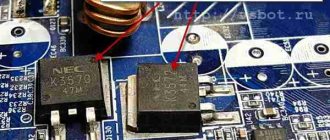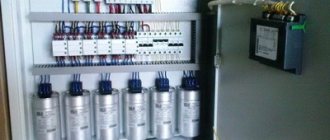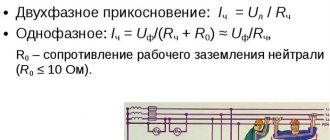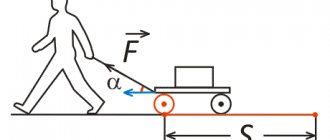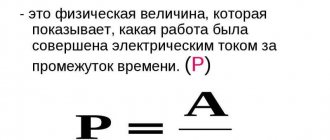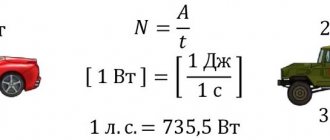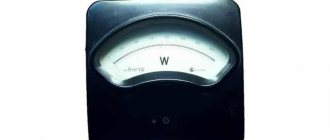Power in watts and kilowatts: a detailed analysis of the relationship between power values
Power is measured by a single unit, that is, Watts, which are designated W in markings and calculations.
According to the international system, Watts are classified as derived measurement values.
Sometimes Watts are converted to Kilowatts (denoted by the letters kW) for more convenient measurements and calculations. Moreover, the equivalence of these notations is quite simple. Let's look at how watts and kilowatts relate to each other.
Learn more about value ratios
Watts are derived units. This means that values are expressed using basic system units. One W is the power of one joule per second. So the power looks like this:
In addition, watts can be expressed in terms of joules and newtons.
People use prefixes to indicate that a value is a multiple of ten of its original value. Kilo is a common prefix, translated from Greek it means 1000.
If this prefix is used, it means that the indicator has been increased tenfold.
The formula for converting Watts to kilowatts will look like this:
Kilowatts refers to the power of many electrical appliances that we use every day.
These include vacuum cleaners, microwave ovens, and many other devices. Engines in cars are also calculated by this value, although in cars this value can also be represented in horsepower.
But horsepower is outside the system, and has been used since the moment when the power of a machine was calculated by the number of horses it could withstand. The kW value is quite easy to convert into them:
Thus, as can be understood from the above, 1 kW equals a thousand watts. Compared to the first formula (1), the second will look like this:
To convert W to kW, you need to increase the W value tenfold.
To obtain Watts from kW, you need to perform the reverse operation accordingly and divide the kW value by ten to the minus third power.
There are tables that can make the calculation much easier. For example:
Let's look at examples
In life, converting Kilowatts to Watts and vice versa occurs quite often. Let's look at a few examples where such calculations can be useful.
- The electric motor has a power of 1.5 kW. You need to understand what the engine power will be in W. Multiply kilowatts by a thousand. We get:
- Tables of values contain a nominal mechanical power of nine hundred watts. In Kilowatts we get the following:
Kilowatts are constantly encountered in our lives.
For example, when paying for electricity, it is often measured in kilowatts per hour of energy use. This shows how much energy an object consumes in one hour of operation. In this case, the power of devices is often calculated in Watts.
If we want to know how much 500 watts are spent per hour, we need to make the following calculation:
Summarizing
So, where in real life you might need conversions from W to kilowatts and vice versa:
- The ability to apply such simple calculations in life will help you plan your electricity expenses;
- Knowing the units of measurement will help determine the wire cross-section for electrical wiring and select suitable protective devices;
- Different devices have different values, so you can adjust them to a single value and sum them up.
- Such knowledge is simple and necessary for every person, since such measurements relate to calculations in physics in high school classes.
Now you know how to correctly convert Watts to Kilowatts, how to do the opposite action and why this is needed. Don’t let physical quantities scare you, because making calculations is easy and interesting!
How much does a washing machine consume per month?
Yes, I know that after the post about boiling tea in the microwave, everyone is waiting to compare the kettle with an electric stove, but a wattmeter is not suitable for this, because... The stove has a different outlet, and for measurements you will have to use an electric meter, turning off all other consumers in the apartment, but you just can’t get around to doing that. I will definitely do this soon.
In the meantime, I’ll try to answer the question of whether it’s really worth bothering to put the washing machine on at night in order to save on the nightly electricity tariff, and in general, whether it consumes a lot. Suddenly? I’m shocked, but I’ve been interested in this question for a long time.
My washing machine is Electrolux EWS 10410W, like this:
It has the following efficiency parameters:
Here, by the way, the estimated energy consumption is indicated; at the end we will try to estimate the calculations with it.
Since I don’t know much about energy efficiency classes, I dug up a cheat sheet:
I’ll add that modern washing machines have class “A” with a lot of advantages, that is, my washing machine is still considered average.
I took a wattmeter and stuck it somewhere under the kitchen unit in the back of the washing machine, leaving it like that for a month. After a month I was too lazy to take it out (it’s very difficult to get into it), so I took the readings on the 37th day of measurements. This is what I saw there:
For 37 days, the washing machine consumed 10.67 kWh, which corresponds to 8.8 kWh/month.
Now about the number of washes. During this time, 10 washes were done. Most often the wash was set for 2 hours at 60 degrees, spin 1000 rpm, but a couple of times it was an hour and a half, 40 degrees and 900 rpm.
Let's move on to the calculations.
In St. Petersburg, our daily tariff is 4.06 rubles/kWh, and the night tariff is 2.34 rubles/kWh. Thus, with a daily tariff, the washing machine will wind up 35.72 rubles
, at night -
20.59 rubles
.
The difference is 15.13 rubles
per month. This is even less than the savings from not using an electric kettle! At the same time, the price of one wash turned out to be 4.3/2.5 rubles per day and night, respectively (not counting 3 rubles for water).
Now let’s compare our measurements with calculations based on the washing machine’s passport. To do this, let's take:
the total time of washing is 18.5 hours, the average load of the washing machine is 3 kg (I estimated based on the maximum 4.5 kg according to the passport), the consumption according to the passport is 0.19 kWh/kg, we multiply everything, we get the estimated consumption for 37 days - 10.55 kWh, for month - 8.7 kWh
. Oh my God, it came together!
Conclusion: the statement about the possibility of saving on overnight washing is a little exaggerated; it’s easier not to sweat and start the washing machine when it’s convenient. But if 15 rubles a month is not too much, then it’s better to pay for the night.
Methods for determining the electricity consumption of household appliances and tools
The average electricity consumption in citizens' apartments per month is the sum of the total electricity consumption of all electrical appliances used by its residents. Knowing the electricity consumption for each of them will give an understanding of how rationally they are used. Changing the operating can provide significant energy savings.
The total amount of electricity consumed per month in an apartment or house is recorded by the meter . There are several ways to obtain data for individual devices.
A practical way to calculate electricity consumption based on the power of an electrical appliance
The average daily electricity consumption of any home appliance is calculated using the formula ; just remember the basic characteristics of electrical appliances. These are three parameters - current, power and voltage. Current is expressed in amperes (A), power in watts (W) or kilowatts (kW), and voltage in volts (V). From the school physics course, we remember how electricity is measured - it is a kilowatt-hour, it means the amount of electricity consumed per hour.
All home appliances are equipped with labels on the cable or on the device itself, which indicate the input voltage and current consumption ( for example, 220 V 1 A ). The same data must be present in the product passport. Based on current and voltage, the power consumption of the device is calculated - P=U×I, where
We substitute the numerical values and get 220 V × 1 A = 220 W.
Next, knowing the power of the device, we calculate its energy consumption per unit of time. For example , a regular liter electric kettle has a power of 1600 W. On average, it works 30 minutes a day, that is, ½ hour . We multiply the power by the operating time and get:
1600 W × 1/2 hour = 800 W/h, or 0.8 kW/h.
To calculate costs in monetary terms, we multiply the resulting figure by the tariff , for example, 4 rubles per kWh:
In this way, calculations are made for each electrical appliance in the house.
Counting electricity consumption using a wattmeter
The calculations will give you an approximate result. It is much more reliable to use a household wattmeter , or energy meter - a device that measures the exact amount of energy consumed by any household device.
Its functions:
The wattmeter is plugged into a socket and the device you are going to test is connected to it. The display shows power consumption parameters.
Current measurement and determination of power consumption of household appliances using current clamp meters without breaking the electrical circuit
clamps allow you to measure the current and determine the power consumed by a household appliance without disconnecting it from the network . Any device (regardless of manufacturer and modification) consists of a magnetic circuit with a movable disconnect bracket, a display, a voltage range switch and a button for recording readings.
Determining energy consumption using an electric meter
A meter is another simple way to determine the power of a household appliance.
How to count light using a meter:
The resulting number will be an indicator of the electricity consumption of the individual device.
What is power consumption?
Power consumption is a numerical measure of the amount of electrical energy required for the operation of an electrical appliance or converted by it during operation. For static devices (stove, iron, TV, lighting), current energy turns into heat during operation). During conversion (electric motors), the energy of electric current is converted into mechanical energy.
The basic unit of electrical power is Watt, its numerical value
where U is voltage, Volts, I is current, amperes.
Sometimes this parameter is indicated in V×A (V×A for imported equipment), which is more correct for alternating current. The difference between Watts and VA for household networks is small and can be ignored.
Electrical power consumption is important when planning wiring (the cross-section of the wires depends on it, as well as the choice of ratings and the number of circuit breakers). During operation, it determines the costs of maintaining the home.
The problem of proper operation of the household electrical network
From a constructive point of view, the household electrical network has been developed to a high degree of perfection: its normal operation does not require special knowledge.
The network is designed for certain operating conditions, the violation of which leads to complete or partial failure, and in severe cases, to a fire.
The condition for proper operation is the absence of overload.
At the same time, the load capacity of sockets and the consumption of equipment connected to them are measured in different units:
- for sockets this is the maximum permissible alternating current (6 A for traditional Soviet sockets of old housing stock, 10 or even 16 A for European-style sockets);
- connected equipment is characterized by power, which is measured in Watts (for powerful devices, larger units are indicated instead of Watts: kilowatts (1 kW = 1000 W), which allows you to avoid confusion with numerous zeros).
Hence the need arises:
- determining the relationship between power and current;
- finding the power of an individual electrical appliance.
The relationship between Watts and Amps is simple and follows directly from the definition of Watt above. The task is simplified by the fact that the voltage of a working household network is always the same (220 or 230 V). From here, power is always found along the current.
Features of determining network power
In general, the electrical network is designed so that its operation does not require special knowledge. It is enough to follow some rules, the main one of which is to prevent overload.
Important! Failure to comply with the rules for using the electrical network can lead to failure and even fire.
It is important to note that the technical characteristics of the outlet and the household appliance differ from each other:
How to calculate the power of electricity? To calculate, you will need a formula:
U - voltage in Volts,
I is the current strength in Amperes.
The voltage of a working outlet is 220-230 Volts; the current can be measured with a multimeter.
To determine the current strength in the outlet, you should use a multimeter
How to determine?
To solve the problem of finding power, you can use various methods. All of them are available for use even with knowledge of physics and electrical engineering at the school curriculum level.
More often, power is found by determining the current; sometimes you can do without intermediate procedures and determine it immediately.
We look at the technical passport
Typically, the power consumption is indicated in the passport or description of the device and is duplicated on the nameplate. The latter is located on the rear wall of the case or its base.
If there is no description, this parameter can be found on the Internet, for which you just need to search by the name of the device.
The power indicated by the equipment manufacturer refers to peak power and is consumed from the network only at full load, which is quite rare. The resulting difference is considered as a reserve. At the regulatory level, this reserve is determined through the power factor.
Ohm's law to help
The power of most household electrical devices can be fairly accurately estimated experimentally and by calculation using Ohm's law, known since high school. This empirical law relates voltage, current and load resistance R as:
P = U 2 /R. U = 230 V, and the resistance is measured by a tester. The following is a simple calculation using the formula P = 48,400/R W.
For example, with R = 200 Ohm we obtain power P = 240 W.
The method does not take into account the so-called reactance of the device, which is created primarily by input transformers and chokes, and therefore the resulting estimate is somewhat overestimated.
We use an electric meter
When determining power from a meter, you can proceed in two different ways. In both cases, only the device under test should be powered from the household network. Without exception, all other consumers must be disconnected.
In the first approach, an optical meter indicator is used to measure power, the intensity of its flashes is proportional to the power consumption. The proportionality coefficient is indicated on the front panel in units imp/kWh or imp/kWh, Figure 1, where imp is the number of pulses (indicator flashes) per kilowatt hour.
Figure 1. Front panel of a household electricity meter with optical indicator
After turning on the device under test, you must begin counting the indicator flashes for 15 or 20 minutes. The resulting value is then multiplied by 3 or 4 (for a 20- or 15-minute measurement interval, respectively) and divided by the coefficient from the front panel. The result of the calculation gives the power of the device in kW, which in some cases is conveniently converted into Watts by multiplying by 1000.
Example. For the counter we have k = 1600 pulses per kilowatt hour. With a 20-minute measurement interval, the indicator worked (flashed) 160 times. Then the power of the device will be 160*3/1600 = 0.3 kW or 300 W.
The second approach also uses a 15- or 20-minute time interval, but the energy consumption is determined on a digital scale. For example, with a difference in readings over 20 minutes of 0.2 kW×hour, the power of the unit is 0.2 × 3 = 0.6 kW or 600 W.
Wattmeter
A modern household power meter or wattmeter is convenient to use because:
- it is connected directly to the open circuit, for which it is equipped with a plug and socket, see Figure 2;
- equipped with an easy-to-read digital indicator and equipped with internal automatic adjustment circuits, which eliminates errors in readings;
- has good weight and size characteristics.
The device is ready for use immediately after switching on.
Rice. 2. Digital household wattmeter
Its only drawback is its narrow specialization, so this device is rarely found in the household.
How to find out the power of the device
You can do this in several ways:
- Look in the technical data sheet or on a special sticker (label) on the device. The latter is usually located on the back wall or base.
- View specifications for the device model on the Internet.
- Using an electricity meter. It is necessary to turn off all other current consumers, measure the indicator, then turn on the desired device and wait 15 minutes. Then measure the indicator again and multiply the resulting difference by 4. The result is current consumption per hour.
Using a meter you can measure approximate power
- Using Ohm's law: P = U2 / R, where U is the voltage of 230 V, and R is the resistance that must be measured with the tester.
- Wattmeter: This is a meter that is an “adapter” between the outlet and the device. When turned on, the exact value will appear on the indicator.
The manufacturer usually indicates the maximum power - the equipment will not consume more than this value. In its normal state, the device requires less energy; when calculating, it is worth taking the maximum value.
If you determine it yourself, you will get an average number - this is how much equipment consumes on average. This number should be increased slightly so that there is a small margin left.
When determined using a wattmeter, the figure turns out to be extremely accurate - this is how much current the device consumes at a particular moment. The value should also be increased slightly.
Direct current measurement
The methods of that group are characterized by higher accuracy due to the fact that they are based on direct measurement of current. There are two devices for performing this procedure at home.
Metering with current clamps
The most convenient to use are current clamps that do not require breaking the controlled circuit. Designed as a hand-held device with a measuring unit based on a toroidal core. To measure the current, the assembly is opened in the manner of pincer sponges, and then closed to cover the wire, Figure 3. The effective value of the current is determined by the change in the magnetic field, which is recorded by the Hall sensor.
Rice. 3. Measurement with current clamps
Measurement with a tester
The second method is based on the use of a tester, which is switched to ammeter mode and connected to an open circuit. The difficulties of implementing this procedure using simple means make it little popular in practice. We also cannot discount the fact that some tester models do not have current protection and fail (burn out) if the range is incorrectly selected (current overload).
Measuring consumption by the device
It will not be possible to find out exactly the real consumption using only the formula. You can use an electricity meter in principle. But the most convenient option is a special meter for the outlet. It is quite common and often found on sale; you can find it by its name - energy meter, or wattmeter.
Using such a measuring device, you can obtain the following data:
To start measuring, just plug the wattmeter into a power outlet. It also has a socket. The measuring devices are connected there. Once connected, power, voltage, current, consumption and other indicators will be displayed in real time, depending on the settings.
Expert opinion
It-Technology, Electrical power and electronics specialist
Ask questions to the “Specialist for modernization of energy generation systems”
Features of three-phase meters You will need to write down the values, wait until the required data is displayed on the display, or scroll through the values to the appropriate page. Ask, I'm in touch!
Watt calculation: conversion to other units, current and power, energy cost
- Converting Watts to other units
- Current and power
- Calculation of the cost of energy consumption
When purchasing certain electrical appliances, we often encounter problems. The fact is that the technical characteristics of devices are replete with a large number of terms, and not everyone is able to easily understand them. Everything is complicated by the fact that devices are often labeled with different units of measurement. For example, consumers of electrical energy - light bulbs, refrigerators, televisions - are characterized by power. It is usually measured in Watts or kiloWatts. And for sockets, meters, switches and fuses, the value is usually indicated in Amperes or milliamps. In addition, there is a voltage designation (for example, 220 or 380V).
How can we find a correspondence between all these units of measurement and find out whether, for example, it is possible to connect a microwave oven to an outlet without causing unpleasant consequences?
Total electrical power value
Sometimes it is necessary to calculate the total power of household consumers installed in the house. This is necessary for:
- correct choice of cable cross-section when installing electrical wiring;
- selection of control devices, including circuit breakers, electric meters, etc.;
- layout of the wiring system in the house.
Ultimately, correct accounting of the total energy intensity of household appliances ensures the operational reliability of electrical wiring and the safe operation of household electrical appliances.
To calculate the highest possible power of household electrical appliances, you should add up the number of watts indicated in the technical documentation of the equipment or directly on the equipment itself. When performing the calculation, all values must be converted accordingly to the same unit of measurement, taking into account the procedure described above.
Converting Watts to other units
What does the term “Watt” even mean? Watt (W) is an SI unit of power and denotes the work of 1 joule performed by a current in 1 second, or the power of a current of 1 Ampere and a voltage of 1 Volt. Manufacturers provide information about it so that users can calculate the amount of current power consumed, as well as to determine the size of the total load or the load of individual devices. This is necessary in order to be able to determine what the power of the circuit breaker or voltage stabilizer should be.
As mentioned earlier, the basic unit of measurement is the Watt. This means that, if necessary, to carry out a calculation, you must first convert the data used to Watts.
What units are used to measure power? Most often used:
- Watts (W);
- Kilowatts (kW);
- Joules per second (J/s);
- Horsepower (hp).
How to convert from watts to kilowatts? To do this, you need to divide the power measured in Watts by 1000:
100 W = 100/1000 = 0.1 kW.
To convert kilowatts to watts , do the opposite:
40 kW = 40 x 1000 = 40000 W.
Joule per second is a value equivalent to one Watt, i.e. 60 W = 60 J/s.
To indicate the power of engines, a non-system unit of measurement is often used - horsepower. How to determine how many kilowatts are in one horsepower? To do this, simply multiply the value by a factor of 0.736. For example, for an Oka car the maximum power will be from 39 to 53 hp. With. Let's determine how much it is in kilowatts:
39 l. With. = 0.736 x 39 = 28.7 kW.
53 l. With. = 0.736 x 53 = 39 kW.
Origin of the unit of measurement kilowatt/hour
The intensive study of electricity by European scientists began around the 17th century, at which time fundamental discoveries were made that marked the beginning and development of such a science as electrical engineering. Scottish engineer, mechanical inventor (1736–1819) James Watt introduced into use the first unit of power - horsepower.
In 1782, the British Association of Engineers assigned the scientist's name to the unit of power meter - Watt. It must be borne in mind that in Russian the English letter “W” has a double reading, like “V” or “Ua”. Therefore, we read the name of the inventor as Watt, and the unit of measurement is Watt. In 1889, the unit of measurement gained worldwide recognition. Only in 1960, “Watt” officially entered the international SI system as a power meter for any type of energy, be it thermal, mechanical or electrical.
The energy consumption consumed over a certain period of time is measured in W/h. To reduce the number of symbols when indicating the power consumption of an electrical appliance, a unit such as kilowatt/hour - kW/h (1000 Wh) was introduced into use.
Current and power
To determine what power electrical appliances can be connected to the network, you need to know 2 parameters - voltage and current that the fuse or socket can withstand. There are usually no problems with tension. The most commonly used are 220 V (in apartments and for loads less than 15 kW), 380 V (in industrial enterprises) or 12 V (in a car).
The most commonly used current values and their corresponding power can be found in the table below.
Converting from Amperes to kilowatts using a table is not difficult: in the first column you need to find the current strength indicated on the machine or fuse, then select the required voltage in the first line, find the cell at the intersection of the line with the current strength and the column with the voltage.
For example, the maximum current that an outlet in an apartment is designed for is 16 A. The network voltage is 220 V. Accordingly, the maximum load that this outlet can withstand is 3.52 kW. This means that you can easily connect a TV, iron or hair dryer to it. However, connecting a boiler with a power of 6 kW to it will lead to the fact that the outlet will begin to melt and may even catch fire.
What to do if the required current value is not presented in the table? You should calculate it yourself using a simple formula: P = IU, where P is power, I is current, U is network voltage. It can also be used in a situation where the power of an electrical appliance is known, and the current strength needs to be determined for it. In this case, the formula is transformed into the following relationship: I = P/U.
Let's consider this example. An oven with a power of 2000 W was purchased. Can I plug it into a 10A outlet? Since houses usually use a voltage of 220 V, we perform the calculation as follows: I = 2000/220 = 9.09 A. Since we received a value that does not exceed the maximum permissible, we conclude that using such an outlet to connect an oven it is possible, but only if the condition of the outlet and wiring in the house is good.
Total electrical power value
Sometimes it is necessary to calculate the total power of household consumers installed in the house. This is necessary for:
- correct choice of cable cross-section when installing electrical wiring;
- selection of control devices, including circuit breakers, electric meters, etc.;
- layout of the wiring system in the house.
Ultimately, correct accounting of the total energy intensity of household appliances ensures the operational reliability of electrical wiring and the safe operation of household electrical appliances.
To calculate the highest possible power of household electrical appliances, you should add up the number of watts indicated in the technical documentation of the equipment or directly on the equipment itself. When performing the calculation, all values must be converted accordingly to the same unit of measurement, taking into account the procedure described above.
Calculation of the cost of energy consumption
Speaking of power, one cannot help but recall the calculation of the cost of electrical energy consumed in the apartment. How can you check how much energy will be used in a certain time? To calculate the Watts consumed in 1 month, as well as the cost of energy spent , you need to know:
- What electrical appliances are used in the house and for how long;
- Power consumption of each of these electrical appliances;
- Cost 1 kW/h.
Let's say you need to calculate how much it will cost to use a vacuum cleaner for 1 hour once a week. The power of the vacuum cleaner is indicated on the label located on the back or bottom. Let's assume that this household appliance consumes 1.2 kW. This means that 1200 W will be used when operating the device for an hour. Typically, manufacturers report a maximum value that is often higher than the average power value. The vacuum cleaner only works 4 hours a month. Per month for the device to work you need:
1.2 kW x 4 = 4.8 kW.
Now, to understand how much it will cost, all that remains is to multiply the resulting value by the cost of 1 kW/h. The price of electricity may vary for different cities and times of use. For example, let’s consider the current cost of one kilowatt-hour as of December 31, 2017 for St. Petersburg when using a tariff differentiated by 2 zones (day and night) during the daytime. The tariff rate will be 4.55 rubles per 1 kW/h.
The calculation will look like:
4.8 kW x 4.55 = 21.84 rub.
At first glance, the amount looks quite small, but it is worth remembering that a vacuum cleaner is far from the only electrical appliance used in the house. In order to get a complete picture of the amount and cost of energy per month , there are 2 methods:
- Manual calculation: for each device that uses energy, the power consumed per month is indicated according to the example indicated above. Allows you to determine approximately how much energy will be used per month.
- Using a wattmeter: connecting a measuring device between an electrical appliance and the network. Using this method, you can get a more accurate value, and many models can immediately show the power in kilowatt-hours.
Consumption by household appliances
You can make a plan for energy costs in your home by analyzing how much will be spent on basic household appliances. To get a little orientation in the consumption of most of them, you can consider some specific examples.
The main source of consumption is the system unit. It has a power supply installed, and once you know its power characteristics, you can estimate the approximate consumption. As a rule, this is 300-600 W. But this is the maximum power; it is unlikely that the computer will only consume even under full load.
Useful tips Connection diagrams Principles of operation of devices Main concepts Meters from Energomer Precautions Incandescent lamps Video instructions for the master Testing with a multimeter
Power consumption of kitchen electrical appliances: values, nuances and conclusions for sockets
Electrical appliances with a power of no more than 3.5 kW can be connected to an electrical outlet. This limitation arises due to such a parameter as the rated current of the electrical outlet, usually 16A.
Let's see how much power kitchen electrical appliances consume. Comparing the power of kitchen appliances with a value of 3.5 kW, we can draw the following conclusions:
- Do I need to put an electrical outlet under the device? An alternative is to power the device directly from the power cable or from a power outlet.
- Is it possible to turn on two electrical appliances at the same time if they are powered by a double electrical socket (the rated current of a double socket is the same as that of a single socket, it is 16A)?
Power of large and small kitchen appliances
Large kitchen appliances
When the refrigerator is turned on for a few seconds, the power consumption will be 3-4 times higher than that which will be in the operating mode (an explanation for this phenomenon can be found by searching for “starting currents”).
When you turn on the dishwasher, the power consumption is approximately 3-4 times higher than the operating power.
Connection using a power cable directly to the terminals or via a power socket
Depends on the model, see the manufacturer's instructions for more details
Maximum power for machines with a drying function.
When you turn on the washing machine for a few seconds, the power consumption will be 3-4 times higher than that which will be in operating mode.
Built-in kitchen appliances
Depends on model
A modern electric hob with 4 burners is often connected using a power cable with a cross-section of at least 4 mm 2
. A household electrical outlet is not required for this hob.
Connection using a power cable directly to the terminals or via a power socket
